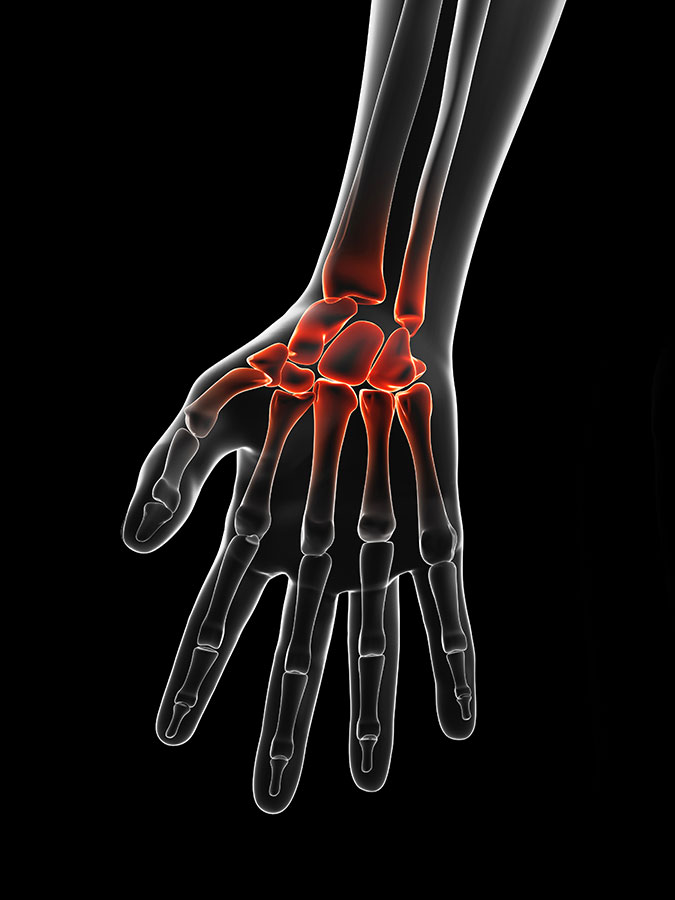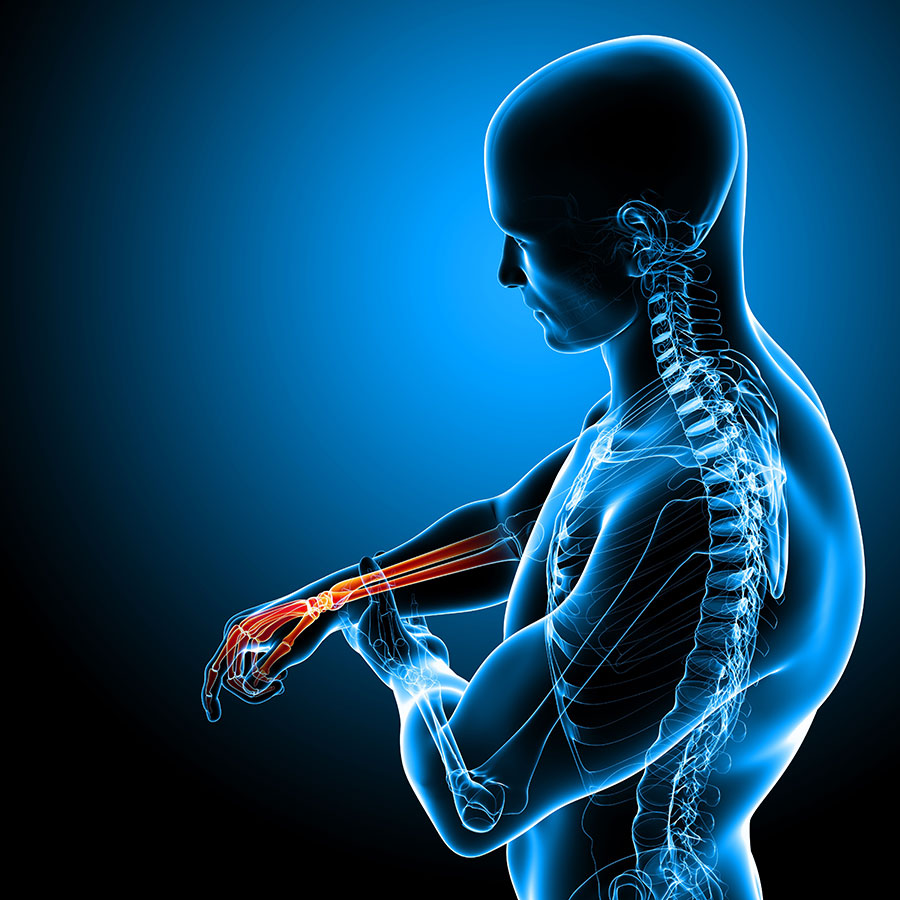The wrist and hand is a very intricate and a detailed assessment can determine the source of the pain, but be warned that injury to these areas can cause long standing problems if not addressed correctly. If you struggle with activities like gripping, lifting, writing, gardening, typing, knitting, can be an indication that your injury is worse than you thought, because all these task are low load activities meaning that it does not take a lot of effort to perform them.
Carpal Tunnel Syndrome is one of the most common causes of wrist pain. Symptoms determine the source of the pain. Injuries to the wrist can cause long term problems if not treated correctly.
Force of impact like Racket sports, heavy landings/falls, being bent back by a fall are common causes of wrist pain. All of these can cause significant pain and discomfort in the wrist making it difficult or even impossible to do anything with it. The small bones in the wrist doesn’t need much to crack, dislocate, or break.
Technically there are no muscles in the wrist itself, there are merely tendons that crosses the wrist, and their muscle bellies are located in the forearm.
Tendon pain
Tendons that run across the wrist to the fingers
The tendons that run to the fingers are a collection of ropes that forms 3 group.
The fist 4 tendons runs at the top (called Superficialis) to the middle part of the finger. Flexor Digitorum Superficialis. You will to be unable to bend the middle joints of your fingers when these tendons are cut.
Deep to this group is another group of 4 tendons that run to the tips of your fingers, Flexor DIgitorum Profundus. You will to be unable to bend the tip joints of your fingers when these tendons are cut.
Flexor Pollicis Longus runs to the thumb. You will to be unable to bend your thumb when this tendon is cut.
At the top of the wrist
On the palm side of the hand there are a group of tendons that bend the wrist forward, then there are a group of tendons that run across the wrist further up to the fingers. The tendons that mainly bends the wrist are the Flexor Carpi Ulnaris and Flexor Carpi Radialis, these anchor directly onto the small carpal bones. One tendon assists with bending the wrist called the Flexor Palmaris longus.
Tendons that move the wrist
Flexor Carpi Ulnaris & Radialis, are two tendons that anchor directly onto the wrist, with your palms facing upward, Ulnaris on the inside and Radialis on the outside, separately each one can pull the wrist more inwards (Ulnaris) or outwards using (Radialis). When they contract together their combined force bends the wrist forward.
Cut to these tendons may leave you unable to bend your wrist. If it happens in isolation, Ulnaris will have loss of movement inward, similarly when Radialis is cut you will lose the ability to move your hand outwards. Other pain in the wrist tendons may be caused by irritations to these tendons namely Flexor Carpi Ulnaris & Radialis Tendinitis.
Tendons on the palm side of the wrist
On the palm side of the hand there are a group of tendons that bend the wrist forward, then there are a group of tendons that run across the wrist further up to the fingers. The tendons that mainly bends the wrist are the Flexor Carpi Ulnaris and Flexor Carpi Radialis, these anchor directly onto the small carpal bones. One tendon assists with bending the wrist called the Flexor Palmaris longus.
Carpal Tunnel syndrome is the most common nerve problem encountered in the wrist. This involves narrowing of the space inside your wrist that directly puts pressure on the Median nerve that supplies your thumb, index finger & middle finger.
Carpal tunnel syndrome is widely misunderstood and thousands of treatments and gadgets that claim to relieve the pain. Understanding what causes the pain will make you think for yourself. The carpal tunnel is an arch formed by the small bones in the wrist. Inside this tunnel, runs the tendons form the forearm to the hand as well as a nerve. When constant pressure is applied on the tendons and the nerve, they become irritated and swollen. The swelling in this confined space will lead to more compression and the pain doesn’t relieve.
The Ulnar nerve runs through its own tunnel called the guyon’s canal. Ulnar nerve damage & injury causes nerve pain radiating towards the little and ring finger.
Radial nerve runs over the thumb side of the wrist and mainly supplies the top part of the thumb, top of the whole hand up until the middle joint of the fingers. A drop wrist is the most common injury to the Radial nerve leaving you unable to lift your wrist & finger up.

There are 8 small Carpal bones tightly arranged next to each other in two rows in the wrist, the Lunate bone connects to the Ulna and the Scaphoid connects to the Radius.
The most commons condition that affects these contact-points between the bones are joint degeneration or arthritis. Arthritis of the wrist joints are a combination of wear & tear and destruction of the cartilage (cushioning) where the bones meet. Different types of arthritis can also be a main cause of wrist pain which will appear to be worse in the mornings and improve as the day goes on. Stiffness can be felt after a period of rest (after a nights sleep). Burning and warm feeling over the joint is usually a very good indicator of arthritic pain.
Osteoarthritis is progressive wasting away of the bone, like the tires on your car that’s thread gets driven through. Rheumatoid arthritis is a autoimmune, inflammatory disease where your own immune system destroys the inner cushioning between the contact surfaces of the bone.
Then the normal alignment of the carpal bones are disrupted you may have dislocated your wrist. The Scaphoid and Lunate regularly dislocate, and is always accompanied by ligament strains or tears.
Ligaments in your wrist must keep the bones in positions and keeps the joint stable. The ligaments that must keep the carpal bones stable are very tight & stiff. A very small amount of force is needed to tear these ligaments, due to this inability to have some leeway or ‘give. Thus it’s highly likely to tear these ligaments when the carpal bones are dislocated.
Fractures brings its own complications due to the ligaments that attach onto certain parts of the bone, segments of the bone that breaks away and leaves the rest of the bone vulnerable. These separated fragments will increase its likelihood to dislocate.
Due to the small size of the carpal bones they are prone to fracture quite easily and any disruption or excessive force can crack and injure these vulnerable bones.
The Radius is more common to fracture first because it’s attachment to the wrist is bigger as compared to the Ulna. Pain on the side of the thumb is more prominent. The most clear sign of this type of wrist fracture is that you will have difficulty to lift the thumb up (like showing the OK or “sharp” sign)
An Ulna fracture is on the side of the pinky. Almost all of the fractures to the Ulna break off the Ulnar Styloid process. The Ulna Styloid process is a prominent knob that can be seen on the outside and top of your wrist. If you suspect a fracture, pressing on this knob may be extremely painful and our patients even report not being unable see the knob after it is broken.
Wrist fractures and dislocation almost always happen together.

Our professional experience with wrist pain
It doesn’t take much to fracture these bones. Many patients come in with pain that has been troubling them for more than a few weeks. When we take X-rays we usually find an old fracture still trying to heal. Then it’s too late to make changes if the bones has dislocated or started healing in the wrong position. Taking too long to seek medical help or delayed treatment can significantly change the time it takes to heal your wrist pain.
Most common wrist injuries we treat:
- Scaphoid fractures
- Carpal tunnel syndrome
- Extensor digitorum tendinitis
- Flexor digitorum tendinitis
- Carpal (wrist) bone fractures
What needs to be tested to determine the source of your wrist pain
- Grip Strength
- ROM
- Sensation
- Stability
- Joint alignment
- Nerve tension test
- Tendon gliding test
Symptoms of wrist pain
Mild symptoms
- Pain with wrist movement
- Sharp pain when moving against resistance
- Gripping, lifting or carrying is uncomfortable
- Pain turning door knobs; pouring kettles; opening jars & bottles
- Tenderness when pressing on elbow
- More stiffness in the morning
- Pain that eases with activity
Severe symptoms
- Unable to twist the wrist
- Burning pain at rest
- Unable to put weight on the elbow joint (lean on hands)
- Pain through range (bend or straighten the wrist)
- Numbness
- Rigid stiffness
- Constant pain with wrist & hand movement
- Pins & Needles
- Unable to grip objects
- Weakness
- Pain radiating up the forearm
Types of wrist pain & structures they may relate to
Muscle pain in wrist
- Pain gets worse during activity
- Burning or cramp like pain
- Stiffness and tightness
- Dull pain when stretched
- Pain only at the end of range
- No loss of muscle strength
- Able to move your wrist through the full range of movement
- Little swelling
Joint pain in wrist
- Sharp sudden pain
- Worse when moving as compared to static positions
- Pain when doing a specific moment
- Muscle tightness surrounding sharp pain
- Deep pulling feeling when stretched/ moved
- With or without swelling
- Pinching feeling at end of range
- Unable to pinpoint it to one specific spot
- Dull ache over a large area
- Unable to find a pain-free position

